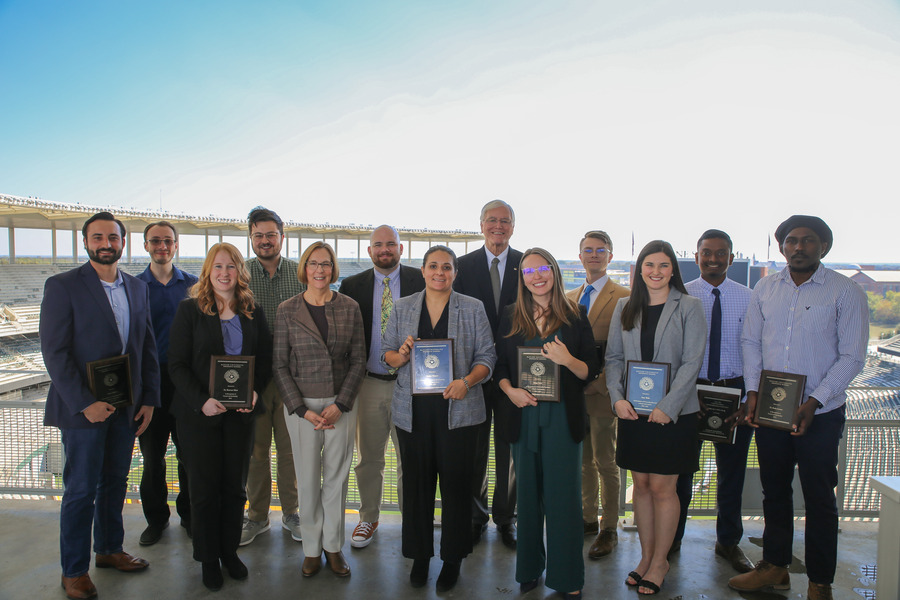Sara Dolan and Bill Hockaday
Associate Deans of the Graduate School
For over 150 years, Baylor has been known primarily for its outstanding undergraduate education, and now our graduate programs are growing in national prominence as well. As Dean Lyon wrote in The Long Upward Climb of Baylor PhD Programs, our doctoral programs are growing in national reputation. As we focus on growing our graduate programs, we also need to double down on providing the “Baylor” experience so that the students in these programs can develop into world-class scholars. The caring, welcoming, inclusive community and the close relationships between faculty, staff, and students is what makes Baylor distinctive among our R1 peer institutions. We can and should be good scholars and good people. We aim for Baylor to be a place of excellence in undergraduate and graduate education.
Dean Rios’s article Growing PhD Enrollment and Graduation outlines the expansion of recruitment efforts and demonstrates the success we have attracting top-notch students to Baylor graduate programs. But once students arrive on campus, we have a responsibility to help them thrive all the way through their graduation. While we still offer all the same resources we have developed over the years, including professional development workshops, the Graduate Writing Center, support for travel to research conferences, and recognizing Outstanding Graduate Student Award Winners, we are promoting new activities that align even more with what our R1 peers are doing.
We are focused on increasing retention and graduation rates through enhancing the student experience. To do this requires the collective efforts of the programs, the colleges and schools, and the Graduate School. This partnership is bearing fruit in a variety of ways. We discuss some of these partnerships in Dean Dolan’s article on A More Inclusive Graduate School, and we highlight programs to support students across programs here.
Baylor is growing, in grant expenditures, in doctoral graduates, and in our physical footprint. Eight Baylor graduate programs have laboratories, classrooms and offices off-campus at the BRIC or in downtown Waco. These include Computer Science, Physics, Electrical and Computer Engineering, Mechanical Engineering, Materials Science and Engineering, Physical/Occupational Therapy, Social Work, and Clinical Psychology. The downtown sites include the Diana R. Garland School of Social Work and the Baylor Research & Innovation Collaborative (BRIC). Problematically, public transit routes do not run from the main campus to the downtown campuses, making them less accessible to a substantial number of students without personal vehicles. The Graduate School has been working with campus transportation and parking services, the Garland School, and the Center for Global Engagement to provide temporary Uber and Lyft ridesharing service while studying student logistical need and transportation provider costs. The goal is to offer a shuttle to downtown campuses at the start of the new fiscal year.
Alongside this type of practical support, we are building more support for student success. This year, we gathered data from current students on their sense of intellectual community and mentoring within their programs. We used these data, in concert with program and college leaders, to develop 1 to 3-year plans for enhancing the student experience within their unit. Many programs used student satisfaction data to expand their program-specific new student orientation so students have a better idea of what their program will look like right from the start. We are also encouraging programs to incorporate a wider variety and a more discipline-specific set of professional development topics into their seminar series. As one example, we know that fewer and fewer PhD students come to graduate school desiring a career as a professor. In programs where more students report an interest in a career in industry, such as in STEM programs, faculty are working with alumni and non-academic professionals in their fields to increase awareness of non-academic career pathways.
Students’ perceptions of their programs are strongly related to their relationship with their faculty mentor. One strong predictor of graduation rates is students’ ratings of this relationship. The faculty mentor shepherds the student through the program, helping them navigate program milestones, develop and execute research projects, and the mentor is often the student’s primary connection to a professional network. Many mentors even serve as a student’s coach and cheerleader through the dissertation writing process. The mentorship relationship is usually the most important academic relationship a student has until they graduate, and strong, positive mentorship relationships can make all the difference for a student.
How are we supporting our graduate students and faculty to engage in improved mentoring relationships?
- We require PhD students and their faculty research advisors to hold and document a discussion about their expectations for their mentorship relationship. This Advisor-Advisee Agreement sets up both the student and faculty member for a more intentional set of experiences so they can together develop the student’s trajectory toward a career as an independent scholar.
- We have developed and disseminated of a wide range of mentoring resources, both general and discipline specific. The resources range from “best practices,” shared by guild organizations to empirical work published in discipline specific journals, and they are available for students and faculty.
- The Graduate School, in partnership with programs, colleges and schools, and the Provost’s Office, is providing mentorship training workshops for graduate faculty, developed by the Center for Improved Mentored Research Experiences (CIMER) at the University of Wisconsin.
The time to bask in the glow of our R1 status is over. Now we strive for the next level of academic experiences for our students. In doctoral programs, this means next-level mentoring and student support, and we are cooperatively working toward providing the “Baylor” experience in our graduate programs.
